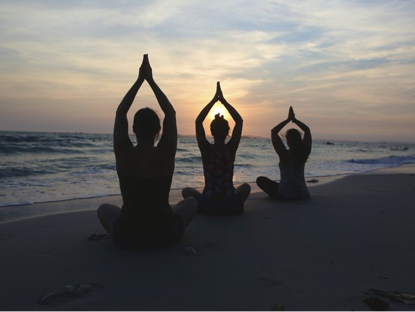5 Steps Towards True Meditation

5 Steps Towards True Meditation
As a yogini, meditation has come up quite a bit in my practice over the years. One of my teachers has advocated for at least one hour of meditation time in a day. In that hour I learn to still my mind, silently chant mantras, and quiet the world outside so that the inner self will emerge.
It may seem easy. After all, how difficult can sitting in sukhasana, closing your eyes and focusing your thoughts be? There is no need to work on your core strength, or your flexibility. All you need to do is breathe and focus. But meditation is hard. And as hard as an asana can be, meditation is still harder. This is because meditation is stripped of all physical embodiments. In an asana, I can focus all my thoughts on grounding my feet. Or pressing my palms down on the mat. My focus is, for the most part, external.
But in meditation, my thoughts are on nothing. My mind is quiet. There is no need for me to focus on something external to keep the mind still because the mind is already void of thoughts and emotions. It is akin to still water. Constant. Unmoving.
For most of us, that seems like an unachievable goal. How can we quiet a mind that is so full of thoughts and opinions? How can we meditate?
- Let’s accept that it is difficult
The first thing to do is to accept that meditation is difficult and a lifelong process. In the eight limbs of yoga, meditation or dhyana features as the 7th limb before enlightenment or Samadhi. This means that the practitioner would have ideally achieved the previous 6 limbs before even attempting dhyana.
True meditation is difficult and probably the most difficult thing you would do in your life. Perhaps you would one day achieve, perhaps you won’t. Understanding this is key to helping you move forward.
- Practice Pranayama, Pratyhara, and Dharana before Dhyana
If you’re practicing yoga, chances are you’re already practicing asanas on a regular basis. Where you can, you should also try to incorporate the practice of pranayama, pratyhara and dharana, and do it in that order.
Through Pranayama, you will learn to connect breath to movement so that your breath flows in a harmonious way. Pranayama is a yogi’s first contact with meditation, as it requires the yogi to consciously focus on breath and nothing else.
Pratyhara, which means withdrawal from the senses, requires us to disassociate from our sense of touch, taste, feel, sight, and hearing. When practicing pratyhara, it is not to say that we don’t experience these senses, rather, we make a conscious effort to withdraw from them and to detach ourselves from them. We may feel happy or sad, but the emotion does not affect us in any way. We become observers of our own emotions instead of participants in it.
Dharana – one-pointed concentration – is a crucial practice to master before one begins to think about meditation. In dharana, we bring our focus inward to focus on a single mental point. Through this concentration, the mind and its ever-flowing thoughts slow down and eventually quiet. In dharana, we begin to bring our focus inwards towards the mind.
Once you’ve mastered these three practices, the process of meditation not only becomes smoother, but also more effective.
- Begin with short periods
Once you are ready to meditate, keep your first few sessions short. Start with 10 minutes each time and then build from there. It is better to be fully still in 10 minutes than to meditate for an hour where only half that time is spent in true meditation. With practice, you will eventually be able to lengthen your time spent meditating.
- Practice, practice, practice!
The work to quiet the mind and focus on nothing is no easy feat. Like the muscles in our body, we can strengthen the mind through practice. It is a myth to say that meditation means to not use the mind at all. Separating your mind from the senses, and disassociating it from the external world is hard work!
Try to meditate daily. Be consistent with your practice and like your asana practice, your meditation will get better.
- Above all, practice aparigraha
It is almost human nature for us to be so fixated on a goal that we’ve set for ourselves. We are, in many cases, results-oriented. In meditation, we look forward to the day that we can achieve that stillness and peace that many have spoken about. Our focus is always on the prize.
Focus is not a bad thing. But ever so often even a focus can turn into an obsession.
Find balance by practicing a sense of non-attachment. Aparigraha. Learn not to be attached to meditation. Understand that what is important is the process. Focus not on the prize but the experience at hand.
Remember that even if you never truly and fully still your mind, it’s okay.
Elaine is a Community Manager at BookMeditationRetreats.com. She is also a yoga teacher who struggles daily with meditation. She believes that quieting her monkey mind will be a lifelong struggle and looks forward to trying to find the silence on her mat daily.
Sarah McLean
Sarah McLean is an acclaimed teacher and thought leader who is determined to create more peace on this planet by helping people wake up to the wonder and beauty of their lives and the world around them through the practices of meditation and mindfulness. She inspires audiences everywhere blending the spirit of Zen wisdom with Vedic knowledge and self-inquiry. She helps demystify meditation and makes it accessible to anyone. It was over 30 years ago when she began her daily meditation practice, and moved in to a Transcendental Meditation community. There, she received advanced training in meditation and studied Ayurveda. Since 1993, when she became the education director for Deepak Chopra’s Center for Mind Body Health, she's been teaching contemplative practices and mind/body health. In 1997, she went to India to live in a traditional ashram in India, When she returned to the States, spent two years as a resident trainee in a Zen Buddhist monastery. She fell in love with Self-inquiry and served as the director of Byron Katie's School for the Work. In 2012, she founded the McLean Meditation Institute, home of the Meditation Teacher Academy which certifies meditation and mindfulness teachers through its 300-hour teacher training program. Her bestseller, Soul-Centered: Transform Your Life in 8 Weeks with Meditation, and her most recent book, The Power of Attention: Awakening to Love have received rave reviews. She now lives in Santa Barbara, California where she trains meditation teachers and offers online classes and lives a life she loves.






